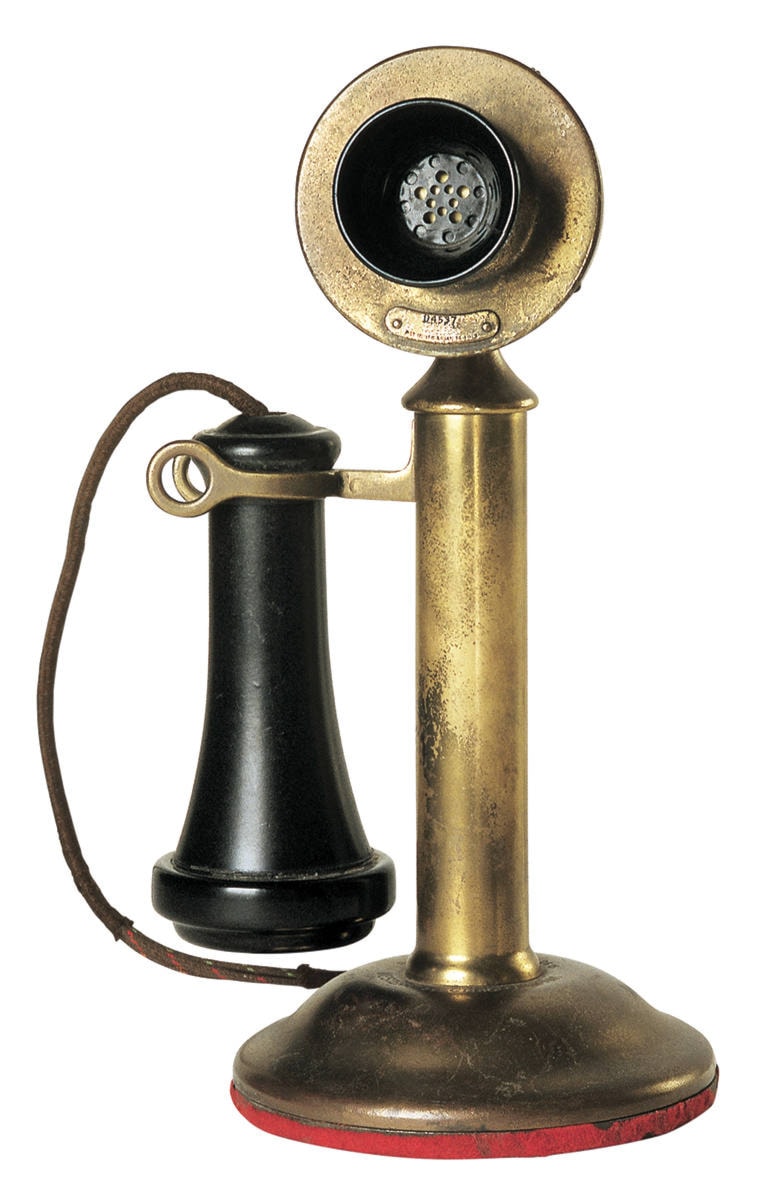Shares in Nanaimo’s first commercial telephone service cost $1.80 each.
To Nanaimo — more specifically Wellington — goes the honour of not only having the first telephones in British Columbia, but of manufacturing them to boot.
Alexander Graham Bell had wrought his magic just a year before. It was a description of his technical marvel in The Scientific American that prompted F.D. Little, the Wellington Mine’s chief engineer (also popularly — or otherwise — known as ‘Dunsmuir’s handyman’ and later general manager of the entire Wellington colliery), to assign mechanic William H. Wall to build such a contraption in 1877.
Guided by the magazine article, Wall utilized shop scraps such as the copper hoops (copper so as not to create a spark) used to bind kegs of blasting powder. By borrowing a large magnet, he was able to polarize his own magnets. The metal diaphragms, necessarily very thin so they’d vibrate in synch with a human voice, was his most ingenious touch — he cut them from a tintype photograph sacrificed for the cause.
Because these prototypes lacked transmitters and receivers, the caller spoke into and listened from the same instrument, like kids’ tin cans on a string. For testing, they were linked together by several hundred yards of No. 14 steel wire. Primitive, yes — but they worked.
However, as the chief engineer pointed out to mine owner Robert Dunsmuir, they lacked copyright approval. Dunsmuir solved this by ordering two manufactured telephones from San Francisco and having them installed between the Wellington colliery and its shipping terminal at Departure Bay, two and a half miles distant. He then wired up his various Nanaimo-area mines to the coaling docks.
Such, 150 years ago, was Nanaimo’s introduction to high-tech.
Commercial telephone service came to town 10 years later, in August ’87. It had been successfully implemented in Victoria and telegrapher J.A. Callaghan was intrigued. “The idea appealed to me,” he recounted many years later. He discussed his proposal with “some of the leading citizens of those days”. Among them were Nanaimo Free Press publisher George Norris, government agent Marshall Bray, Old Flag Inn proprietor John Jenkins, businessman A.R. Johnson, druggist E. Pimbury, hardware merchant John Please, former hotelier Peter Sabiston, stable owner W.L. LeBallister, merchants George Hirst and James Harvey, and hospital president J. Pawson. With their support — requiring an investment of $1.80 each! — Callaghan ordered 12 telephones and a switchboard.
‘Doc’ LeBallister “got the poles,” Callaghan told an interviewer, “and we had a bee and set them up. I worked on the installation and Please on the wiring. The board was set up in John Cavalsky’s store, but it did not work. We got the only known telephone expert in the country, [R.B.] McMicking, up from Victoria and on his recommendation we got a board similar to the one in use in his city. Mr. Cavalsky was the first operator. After about a year the board was moved to a building [owned by LeBallister] on Front Street.”
To accommodate this upgrading, service had been suspended from a Saturday morning through Monday morning.
Edward George Cavalsky, who operated a fruit and produce store on Commercial Street, had agreed to be the first paid operator (initially for eight telephones) rather than be a shareholder but he had to surrender the position when he lost his lease. Although this ended Cavalsky’s personal role with telephones, his son King later became an employee of B.C. Telephone, as did his granddaughter Grace.
Nanaimo Telephone Co. was incorporated in 1890 with 17 subscribers; by 1899, service had grown to 100 users. From such humble beginnings, telephone service was expanded in 1901 to offer long distance to Victoria, Mayors Manson and Hayward having the honour of making the inaugural conversation. “One might have been in the next block to one’s conversation partner, so distinctly was every syllable heard,” it was reported.
Three years later, with 350 subscribers, the Nanaimo company merged with what was then the B.C. Telephone Co. The original crank-turned magneto models were replaced by battery-powered phones and a new switchboard in a new building in 1912, followed, a year later, by the laying of a 32-mile-long underwater cable between Point Grey and Newcastle Island to link the Hub City to the mainland.
And, for trivia buffs, these nuggets: The ever-popular ‘busy signal’ arrived in Nanaimo on Oct. 7, 1955, direct distance dialing in September ’57.
(Written with the help of the late Nanaimo historian John Cass.)
www.twpaterson.com
